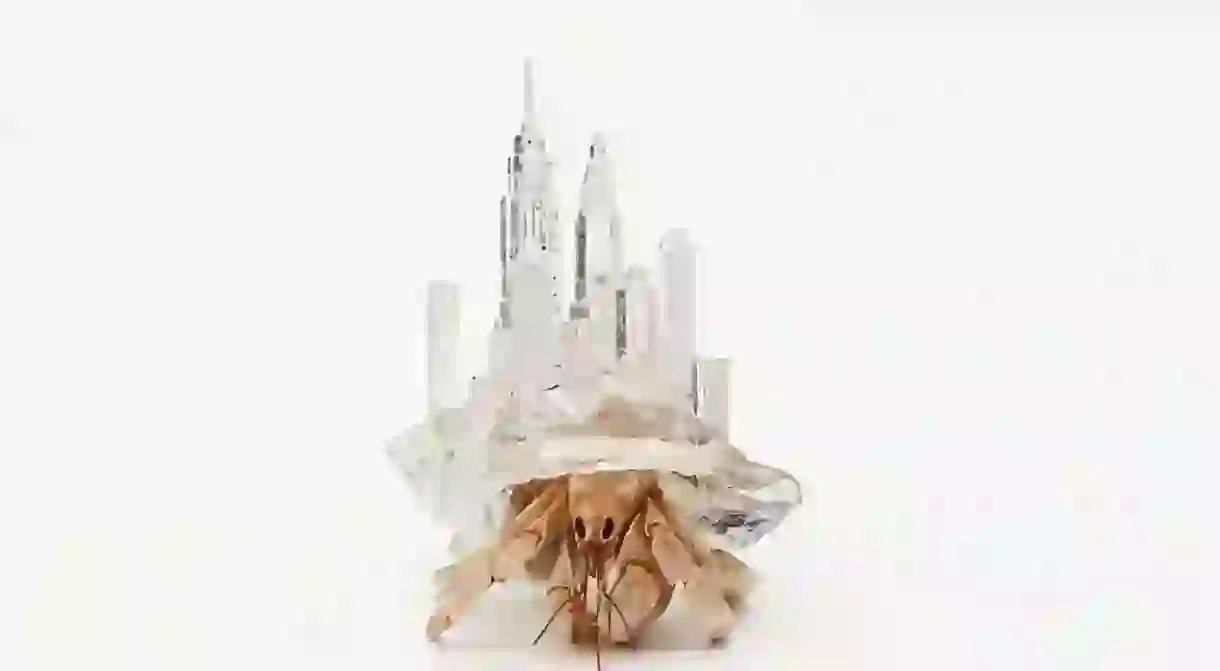Teeny, Tiny Architectural Wonders from Around the World

From crystal cityscapes on the backs of hermit crabs to entire buildings encapsulated in glass test tubes, Think Small: The Tiniest Art in the World pays a delightful homage to teeny, tiny art objects and architectural masterpieces.
Eva Katz’s new book Think Small: The Tiniest Art in the World, which debuted at the beginning of this month, highlights an epic world in miniature. Featuring the work of 24 artists from around the globe, the curated collections include 3-inch mid-century furniture, meticulously crafted micro-skyscrapers made from pencil lead, and small-scale cities carved into crystal shells for hermit crabs. It’s all about the tiny canvas, and some artists found their blank slate on everything from almonds, to matchstick points, and even sesame seeds.
Russian artist Salavat Fidai crafts his architectural monuments from pencil lead using a “slow, deliberate” blade over the course of 12 hours each night, preferring to work on his art while the rest of the world sleeps. He’s managed to capture the likeness of the Eiffel Tower, Statue of Liberty, the Golden Gate Bridge, and more – using only the tip of a graphite pencil as a canvas.

Japanese artist Aki Inomata captured the micro-likeness of New York City, Santorini, Ksar of Ait-Ben-Haddou, and other world destinations in the form of crystal shelters for hermit crabs. She describes the project as a “collaborative work with animals” and a “theatrical performance” with creatures acting out the roles of humans.

On the other side of the world, in Amsterdam, Rosa de Jong suspended small-scale architectural wonders inside glass test tubes. In an exclusive excerpt from the new book, Rosa de Jong discusses her design approach and inspiration with author Eva Katz.
Excerpt from Think Small: The Tiniest Art in the World by Eva Katz, published by Chronicle Books 2018.

Rosa de Jong studied art direction for advertising, but then she quickly started working with her own clients on projects that were more design oriented. Because she started in advertising, she learned to leave everything out that doesn’t work for your story, the famous “less is more” approach. “I don’t think this means everything should be clean and white,” she says. “It just means that you should be aware of what’s essential to your story and what is not.”
What compelled you to go small?
It’s always interesting to take something out of proportion; it makes you look at an object differently. Since I live in a small apartment in Amsterdam it’s not hard to see why I went small. Also, with this project, building a disproportionally big house is not really an option—those already exist.
Can you guide us through your process from idea to completion?
Most of my ideas are made without a sketch or plan. Only when I have a specific idea do I try to make a quick sketch up front. Some of them almost make themselves; for example, if there’s a branch that I think will make the most amazing tree, then I just have to build around it. Other objects need more time to decide what’s right for them. I think the most planning is in just looking at the object, imagining the next step, thinking through different options, and deciding what’s the best way to go. For tools, I use tweezers, a small knife, a paper knife, a triangle ruler, and patience. For materials, I use glass test tubes, cardboard, sticks, train model materials, wire, and sand.

Where do you look for inspiration?
Inspiration is a tricky thing. I love looking at things, mostly online, at design websites and sites like Pinterest, but it can also be discouraging looking at all these incredible things that are being made. For me, probably, most of my inspiration comes from my curious mind and interaction with other creatives I know.
Oh, and let’s not forget nature.
What do you feel changes about your process when you work on large-scale installations versus your tiny pieces?
The bigger you go, the more detail you will need.
Does working with test tubes ever feel constricting?
A little. As an artist, I feel like I should renew myself constantly, instead of just making different versions of my former work. I am working on integrating light into the miniatures, something that doesn’t work well with the test tubes because of the wires. So although I think the test tubes are what make this project stand out, I have also started building outside of them.













